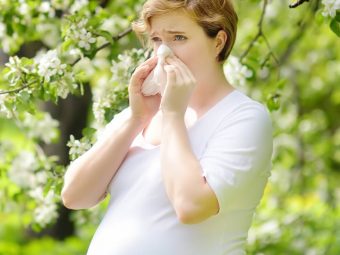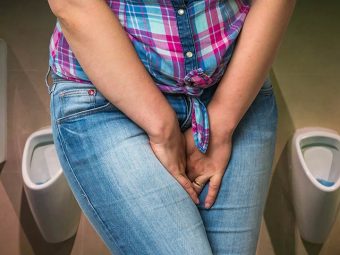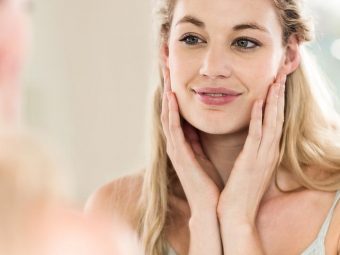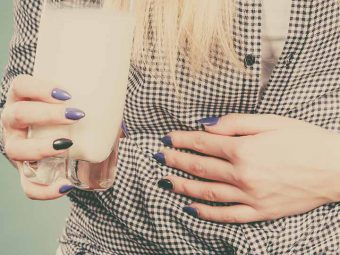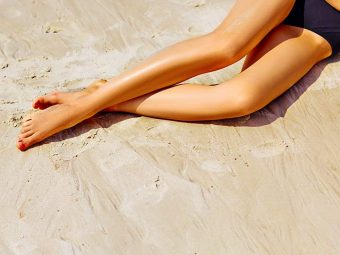10 Natural Remedies To Make Your Eyelashes Longer
Easy natural remedies to get long, healthy eyelashes and surprise everyone.

We all have gone online, finding the best ways to get thicker and longer eyelashes. Most of the times, we end up finding nothing useful, but not this time. Thick eyelashes give a magical lift to the eye makeup besides shielding your eyes from sand, dust, and debris. However, they sometimes tend to fall out and get thin due to various factors, including aging and medical conditions such as hypotrichosis (1) . In this article, we have developed some natural ways to remedy your lashes and make them longer and thicker.
Note: Some home remedies listed below are not backed by scientific evidence to prove their effectiveness in achieving longer eyelashes.
In This Article
Natural Home Remedies That May Give You Longer Eyelashes
1. Castor Oil
Ricinoleic acid is the major component of castor oil and makes up about 90% of it (1). This acid has shown potential in helping with hair loss (2). Thus, it may also be an alternative option for maintaining the thickness of your lashes.
However, a clinical case shows that the high viscosity of castor oil may result in hair matting and extreme dryness (3). Hence, consult your dermatologist before you try this remedy.
What To Do: You will need 1 teaspoon of cold-pressed castor oil and a few cotton swabs. Before applying castor oil, cleanse your eyelashes thoroughly with water and pat them dry with a mild cleanser. Dip the cotton swab in cold-pressed castor oil and apply it along your upper and lower lash lines. Avoid getting the oil into your eyes. Keep the oil on overnight and wash it off the next morning.
2. Coconut Oil
Coconut oil is used for hair care due to its penetrating effect, which helps prevent loss of hair proteins (4). Hence, it may also be used to treat thinning and damaged eyelashes and aid their regrowth.
However, be careful while using coconut oil as it may leave an oily film on your lashes that weighs them down (5).
What To Do: You will need 1 teaspoon of cold-pressed coconut oil and a bunch of cotton swabs. Before applying the oil, cleanse your lashes with mild soap and water before patting them dry. Dip a cotton swab in coconut oil and apply it along your upper and lower lash lines. Avoid getting the oil into your eyes. Leave the oil on overnight. Rinse it off the following morning.
3. Vitamin E
Vitamin E is a powerful antioxidant that can help reduce the oxidative damage causing an increase in hair loss. It also contains tocotrienol compounds that may help increase the number of hair strands (6). Hence, it may contribute to longer eyelashes.
What To Do: Vitamin E can be applied topically to your lashes. It is even safe to ingest as an oral supplement. But before taking the supplements, talk to your doctor for the correct dosage.
4. Green Tea
Green tea is a rich source of a polyphenol called epigallocatechin-3-gallate (EGCG), which can help promote hair growth (7). Hence, it may also help in aiding the growth of your lashes.
What To Do: You will need 1 teaspoon of green tea leaves (or 1 tea bag) and 1 cup of hot water. Mix the two ingredients and steep for 5-10 minutes. Strain the liquid and drink it warm. You can also cool the tea and apply it topically to your upper and lower lash lines using a cotton swab. Drink the tea twice a day and use it topically once daily.
5. Massage
Massaging helps improve circulation. Massaging your scalp regularly, be it with or without oil, can improve hair length and thickness (8). Massaging your eyelids gently may help you get similar results.
6. Lemon Peel Oil
In a study published in Parasitology Research, it was found that lemon oil could help in the treatment of eyelash mites and promote faster hair growth. However, this study was conducted on rabbits (9). More studies are needed to establish the same effects on humans.
What To Do: You will need the peel of 1-2 lemons, coconut or olive oil, and cotton swabs. Place the lemon peels in a small jar and add a few tablespoons of olive or coconut oil to it. Press the peels against the jar using a spoon to obtain the oils from the peels. Allow the mixture to sit overnight. Dip a cotton swab in the mixture and apply it to your upper and lower lash lines, avoiding your eyes. Leave it on for a couple of hours and rinse it off. You may do this 1-2 times daily or leave the mixture overnight.
7. Vaseline (Petroleum Jelly)
Vaseline (petroleum jelly) can moisturize your eyelids and help in getting rid of eyelash mites, preventing further damage to the lashes (10). However, there are no studies on its ability to aid eyelash growth.
What To Do: Take some petroleum jelly (as required) on a cotton swab and apply it to the upper and lower eyelids. Make sure you avoid getting it into your eyes. Leave it on overnight and rinse it off the next morning.
8. Shea Butter
Shea butter is rich in vitamin C and is packed with antioxidants and anti-inflammatory properties (11). Vitamin C prevents free radical damage and boosts collagen. Hence, shea butter may help you maintain the thickness of your lashes and boost their growth.
What To Do: Take a little amount of shea butter and rub it between your fingers until it melts. Apply it to the upper and lower eyelashes. Leave it on overnight.
9. Olive Oil
Olive oil contains a phenolic compound called oleuropein (13). In a rat study, oleuropein was found to increase hair growth (14). Hence, it may contribute to longer eyelashes.
What To Do: You will need 3-4 drops of olive oil and 1-2 cotton swabs. Pour a few drops of olive oil on the cotton ball and apply it to your upper and lower lashes. Leave the oil on for 5-10 minutes, and then rinse it off with lukewarm water.
10. Biotin Supplement
Biotin deficiency can cause loss of hair on the scalp, eyebrows, and eyelashes. Ingesting biotin supplements may help improve this condition (15). Consult a healthcare provider for the correct dosage of biotin supplements.
A combination of these remedies may help in managing your thinning eyelashes. However, you also need to consider making a few lifestyle changes to prevent further damage and thinning of your eyelashes.
How To Prevent Eyelashes From Thinning
- Follow a healthy and well-balanced diet that includes nutrients like iron, zinc, vitamins, fatty acids, biotin, and proteins (16).
- Cleanse your eyelashes and eyelids daily using a mild cleanser or eyelid shampoo (17).
- Avoid using low-quality eye makeup products.
- Avoid any eye makeup that triggers causes irritation.
- Remove makeup before going to bed.
- Stop using eyelash curlers.
- Limit the use of eyelash extensions.
Along with following these remedies and tips, it is also good to know what is causing your eyelashes to thin to get to the root of the problem. Here’s what you need to know.
What Causes The Eyelashes To Thin And Shorten?
Your eyelashes could be falling out due to several factors, such as:
- Advancing age – This is the most common cause of lash fall, affecting both men and women as they age.
- Menopause – Since estrogen plays an important role in the production of collagen for maintaining healthy skin and hair, a reduction in its levels during menopause might result in thin lashes.
- Hormonal imbalances – An imbalance of thyroid hormone can result in damaged skin and hair loss.
- Handling your lashes roughly – Scrubbing your eyelashes vigorously while removing eye makeup.
- Allergic reaction – Particularly to eye makeup products
- Use of eyelash extensions – The glues used to attach the false lashes contain chemicals that may be irritating or harmful. Due to this chemical reaction, you may experience redness, burning, or eyelid inflammation, which may result in eyelash fall.
- Stress
- Chemotherapy – drugs used to treat cancer often cause thinning of hair and lashes.
- Certain medical conditions – Like blepharitis, an overactive/underactive thyroid, psoriasis, alopecia areata, eczema, or trichotillomania
- Poor beauty hygiene – Like leaving the eye makeup on overnight can cause thinning of lashes.
If you exhibit any other symptoms along with the thinning of lashes, it is highly recommended that you consult a doctor to rule out the possibility of an underlying medical condition.
Are Eyelash Serums Safe?
With the growing demand for thick and voluminous eyelashes, many cosmetic brands have started selling eyelash growth serums. In 2008, bimatoprost ophthalmic solution 0.03% was approved as a safe and effective treatment for enhancing eyelash growth (18).
Some cosmetic brands and drugmakers created eyelash growth serums using this as an active ingredient. While these serums provide quite a few benefits, they come with side effects, like red or itchy eyes, eyelid swelling, and irritation. To avoid these issues, check with your doctor before using the serum.
Long and thick eyelashes look incredible, but age, hormonal changes, genetics, allergic reactions, or over-styling may cause eyelashes to fall out or appear short. Shea butter, castor oil, coconut oil, green tea, and vitamin E are among common ingredients known to reduce hair loss and promote hair growth and hence may also help maintain long and healthy eyelashes. In addition, biotin supplementation may be useful if your hair loss from the eyelashes is related to biotin deficiency. To prevent your eyelashes from falling out, limit the use of eyelash extensions, curlers, and low-quality products on your eyelashes or lids.
Frequently Asked Questions
How long does it take for eyelashes to grow back after cutting them?
If you have ended up cutting your eyelashes, do not worry. They should grow right back in 2-3 weeks.
What mascara makes your eyelashes grow?
You will find mascaras from various brands that aim at making your lashes grow longer. Look for mascaras that contain a blend of peptides, proteins, and conditioners that help your lashes grow longer.
What is the best eyelash growth serum?
The best eyelash growth serum in the market is Latisse – the only FDA-approved proven treatment to help with eyelash growth. The key ingredient in this serum is bimatoprost.
Do lash extensions damage your natural lashes?
Yes, lash extensions can damage your real lashes. They require glue to stick to your lashes. When the extensions are removed after use, this glue can make the removal of the false lashes difficult. It can also cause your natural lashes to fall out.
Sources
- Autosomal recessive hypotrichosis, Health Conditions, Genetics Home Reference, US National Library Of Medicine, National Institutes of Health.
https://www.ncbi.nlm.nih.gov/pmc/articles/PMC5015816/ - In silico prediction of prostaglandin D2 synthase inhibitors from herbal constituents for the treatment of hair loss. Journal of Ethnopharmacology, US National Library of Medicine, National Institutes of Health.
https://www.ncbi.nlm.nih.gov/m/pubmed/26456343/ - “Castor Oil” – The Culprit of Acute Hair Felting, International Journal of Trichology, US National Library of Medicine, National Institutes of Health.
https://www.ncbi.nlm.nih.gov/pmc/articles/PMC5596646/ - Effect of mineral oil, sunflower oil, and coconut oil on prevention of hair damage. Journal of Cosmetic Science, US National Library of Medicine, National Institutes of Health.
https://www.ncbi.nlm.nih.gov/pubmed/12715094 - Hair Cosmetics: An Overview, International Journal of Trichology, US National Library of Medicine, National Institutes of Health.
https://www.ncbi.nlm.nih.gov/pmc/articles/PMC4387693/ - Effects of Tocotrienol Supplementation on Hair Growth in Human Volunteers, Tropical Life Sciences Research, US National Library of Medicine, National Institutes of Health.
https://www.ncbi.nlm.nih.gov/pmc/articles/PMC3819075/ - Human hair growth enhancement in vitro by green tea epigallocatechin-3-gallate (EGCG). Phytomedicine, US National Library of Medicine, National Institutes of Health.
https://www.ncbi.nlm.nih.gov/m/pubmed/17092697/ - Standardized Scalp Massage Results in Increased Hair Thickness by Inducing Stretching Forces to Dermal Papilla Cells in the Subcutaneous Tissue, Eplasty, US National Library of Medicine, National Institutes of Health.
https://www.ncbi.nlm.nih.gov/pmc/articles/PMC4740347/ - In vitro and in vivo effect of Citrus limon essential oil against sarcoptic mange in rabbits. Parasitology Research, US National Library of Medicine, National Institutes of Health.
https://www.ncbi.nlm.nih.gov/pubmed/27098160 - Treatment of Phthiriasis Palpebrarum and Crab Louse: Petrolatum Jelly and 1% Permethrin Shampoo, Case Reports in Medicine, US National Library of Medicine, National Institutes of Health.
https://www.ncbi.nlm.nih.gov/pmc/articles/PMC4587429/ - Nutritional composition of shea products and chemical properties of shea butter: a review. Critical Reviews In Food Science And Nutrition, US National Library of Medicine, National Institutes of Health.
https://www.ncbi.nlm.nih.gov/pubmed/24261539 - Topical Vitamin C and the Skin: Mechanisms of Action and Clinical Applications. The Journal Of Clinical And Aesthetic Dermatology, US National Library of Medicine, National Institutes of Health.
https://www.ncbi.nlm.nih.gov/pmc/articles/PMC5605218/ - Active components and clinical applications of olive oil. Alternative Medicine Review, US National Library of Medicine, National Institutes of Health.
https://www.ncbi.nlm.nih.gov/pubmed/18069902 - Topical Application of Oleuropein Induces Anagen Hair Growth in Telogen Mouse Skin, PloS one, US National Library of Medicine, National Institutes of Health.
https://www.ncbi.nlm.nih.gov/pmc/articles/PMC4462586/ - The Role of Vitamins and Minerals in Hair Loss: A Review, Dermatology and Therapy, US National Library of Medicine, National Institutes of Health.
https://www.ncbi.nlm.nih.gov/pmc/articles/PMC6380979/ - Diet and hair loss: effects of nutrient deficiency and supplement use, Dermatology Practical & Conceptual, US National Library of Medicine, National Institutes of Health.
https://www.ncbi.nlm.nih.gov/pmc/articles/PMC5315033/ - Effects of a New Eyelid Shampoo on Lid Hygiene and Eyelash Length in Patients with Meibomian Gland Dysfunction: A Comparative Open Study, Journal of Ophthalmology, US National Library of Medicine, National Institutes of Health.
https://www.ncbi.nlm.nih.gov/pmc/articles/PMC5204100/ - Enhancing the growth of natural eyelashes: the mechanism of bimatoprost-induced eyelash growth. Dermatologic Surgery, US National Library of Medicine, National Institutes of Health.
https://www.ncbi.nlm.nih.gov/pubmed/20384750




